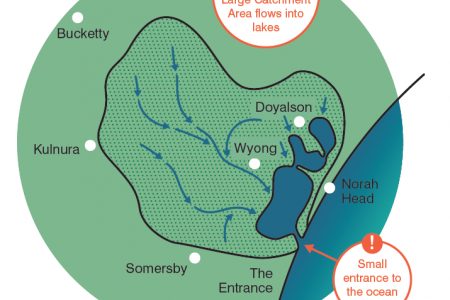Tuggerah Lakes, known as the jewel of the Central Coast, is a barrier estuary located on a broad and open floodplain. It's actually made up of three lakes, linked to each other by shallow and narrow channels, with one narrow connection to the ocean. The lakes' catchment covers a vast area of 710km2, and the estuary itself, at 80km2, is the eighth largest in NSW. Five main tributaries – Wallarah Creek, Wyong River, Ourimbah Creek, Tumbi Creek and Saltwater Creek – flow into the lakes.
Like 70 per cent of coastal lakes and lagoons in NSW, Tuggerah Lakes is classified under the category of Intermittently Closed and Open Lakes or Lagoons (ICOLLs). This refers to lakes that naturally alternate between being open and closed to the ocean. A dynamic sand beach barrier, also known as a berm, which is continuously influenced by the movement and redistribution of sand and sediments, separates ICOLLs from the ocean. These berm changes are also affected by waves, tides, flood flows and winds.
ICOLLs are common on the NSW coast but are a rare feature in other parts of the world.
NSW ICOLLs were formed at the end of the last Ice Age, around 6,500 years ago when sea levels rose significantly.

Water levels and salinity within ICOLLs fluctuate in response to the rainfall. The lakes, along with the life that they support, are all well-adapted to flooding and drying, and – as a result – are incredibly diverse and dynamic.
During wetter times, ICOLLs can open to the ocean to release water. However, in times of drought and reduced rainfall, their entrances close more frequently and for longer periods. Often, these closures can last several years at a time. For Tuggerah Lakes, the longest recorded period was three years (Umwelt, 2011).
Many historical documents show that in the past 100 years, the estuary has closed only 13 times (Worley Parsons, 2009). As well as rainfall, other specific local conditions – the overall catchment’s size and headlands near the entrance – also contribute to the changing nature of ICOLLs. Interestingly, in NSW, about 70 per cent of these types of lakes and lagoons remain closed most of the time (DPI, 2020).

